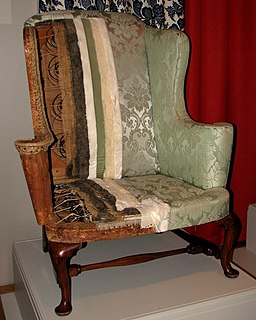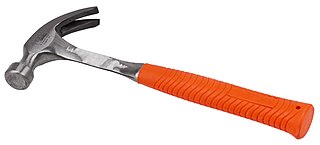
A modern day hammer is a tool consisting of a weighted "head" fixed to a long handle that is swung to deliver an impact to a small area of an object. This can be, for example, to drive nails into wood, to shape metal, or to crush rock. Hammers are used for a wide range of driving, shaping, and breaking applications.

Knitting is a method by which yarn is manipulated to create a textile or fabric, often used in many types of garments.

Quilting is the process of sewing two or more layers of fabric together to make a thicker padded material, usually to create a quilt or quilted garment. Typically, quilting is done with three layers: the top fabric or quilt top, batting or insulating material and backing material, but many different styles are adopted.
A needle is generally a thin, cylindrical object, often with a sharp point on the end.

A perforation is a small hole in a thin material or web. There is usually more than one perforation in an organized fashion, where all of the holes collectively are called a perforation. The process of creating perforations is called perforating, which involves puncturing the workpiece with a tool.
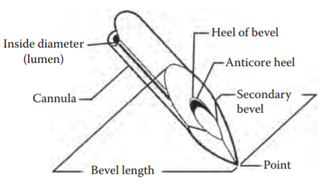
A hypodermic needle, one of a category of medical tools which enter the skin, called sharps, is a very thin, hollow tube with a sharp tip that contains a small opening at the pointed end. It is commonly used with a syringe, a hand-operated device with a plunger, to inject substances into the body or extract fluids from the body. They are used to take liquid samples from the body, for example taking blood from a vein in venipuncture. Large bore hypodermic intervention is especially useful in catastrophic blood loss or treating shock.
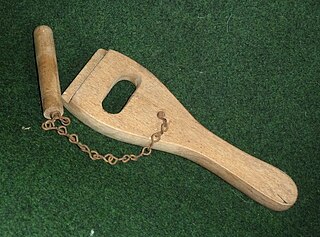
A webbing stretcher is an upholstery tool used to stretch webbing.

A pincushion is a small, stuffed cushion, typically 3–5 cm (1.2–2.0 in) across, which is used in sewing to store pins or needles with their heads protruding to take hold of them easily, collect them, and keep them organized.
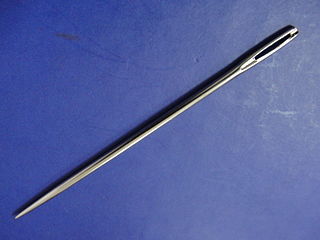
A sewing needle, used for hand-sewing, is a long slender tool with a pointed tip at one end and a hole at the other. The earliest needles were made of bone or wood; modern needles are manufactured from high carbon steel wire and are nickel- or 18K gold-plated for corrosion resistance. High quality embroidery needles are plated with two-thirds platinum and one-third titanium alloy. Traditionally, needles have been kept in needle books or needlecases which have become objects of adornment. Sewing needles may also be kept in an étui, a small box that held needles and other items such as scissors, pencils and tweezers.
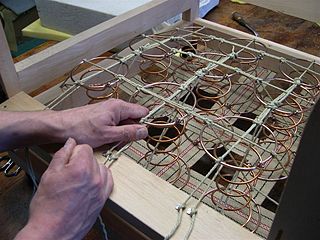
In furniture-making, the upholstery frame of a piece of furniture gives the structural support and determines the basic shape of the upholstered furniture. The frame may be a basic piece of wooden furniture prior to its being upholstered. Like a finished piece of furniture prior to the upholstering, the frame establishes the final quality, including its durability, and sets limits upon the final design, padding, cushioning, or cover.

A ceiling balloon also called a pilot balloon or pibal, is used by meteorologists to determine the height of the base of clouds above ground level during daylight hours. In the past, and sometimes today, a theodolite was used to track the balloon in order to determine the speed and direction of winds aloft. The principle behind the ceiling balloon is that timing of a balloon with a known ascent rate from its release until it disappears into the clouds can be used to calculate the height of the bottom of the clouds.
Upholstery coil springs are an important part of most modern upholstery. The consumer usually never sees the construction features of an upholstered piece. The overall quality of the materials and construction dictate the comfort level of an upholstered piece and its ability to satisfy the consumer over the long term. A basic upholstered piece may be composed of a frame, springs, foam, cushioning, padding, and textiles.

In sewing, a gusset is a triangular or rhomboidal piece of fabric inserted into a seam to add breadth or reduce stress from tight-fitting clothing. Gussets were used at the shoulders, underarms, and hems of traditional shirts and chemises made of rectangular lengths of linen to shape the garments to the body.

Amigurumi is the Japanese art of knitting or crocheting small, stuffed yarn creatures. The word is a portmanteau of the Japanese words ami, meaning crocheted or knitted, and nuigurumi, meaning stuffed doll. In the West they are called amigurumi, which are the original phonetics of 編みぐるみ in Japanese language. Amigurumi vary in size and there are no restrictions about size or look. While the art of amigurumi has been known in Japan for several decades, the craft first started appealing to the masses in other countries, especially in the West, in 2003. By 2006, amigurumi were reported to be some of the most popular items on Etsy, an online craft marketplace, where they typically sold for $10 to $100. Since then, popularity has continued to increase.

Hip and buttock padding is used to increase the apparent size of the hips and buttocks in order to increase apparent waist-hip ratio which implies more feminine body shape. It is used by both sexes: women wishing to increase their physical attractiveness, some transgender people in particular transsexuals and cross-dressers, performers both male in drag and female. This technique is often used by drag queens to create the illusion of a feminine figure, often taking it to the extreme for comedic value.

Leather crafting or simply leathercraft is the practice of making leather into craft objects or works of art, using shaping techniques, coloring techniques or both.

The term Provençal quilting, also known as boutis, refers to the wholecloth quilts done using a stuffing technique traditionally made in the South of France from the 17th century onwards. Boutis is a Provençal word meaning 'stuffing', describing how two layers of fabric are quilted together with stuffing sandwiched between sections of the design, creating a raised effect. The three main forms of the Provençal quilt are matelassage, piqûre de Marseilles, and boutis. These terms, along with trapunto are often debated and confused, but they are all forms of stuffed quilting associated with the region.

Stitch holders are tools that are used by knitters to hold open stitches when not being used by the needles.
Sewing is the craft of fastening or attaching objects using stitches made with needle and thread. Sewing is one of the oldest of the textile arts, arising the in Paleolithic Era. Although usually associated with clothing and household linens, sewing is used in a variety of crafts and industries, including shoemaking, upholstery, sailmaking, bookbinding and the manufacturing of some kinds of sporting goods. Sewing is the fundamental process underlying a variety of textile arts and crafts, including embroidery, tapestry, quilting, appliqué and patchwork.

